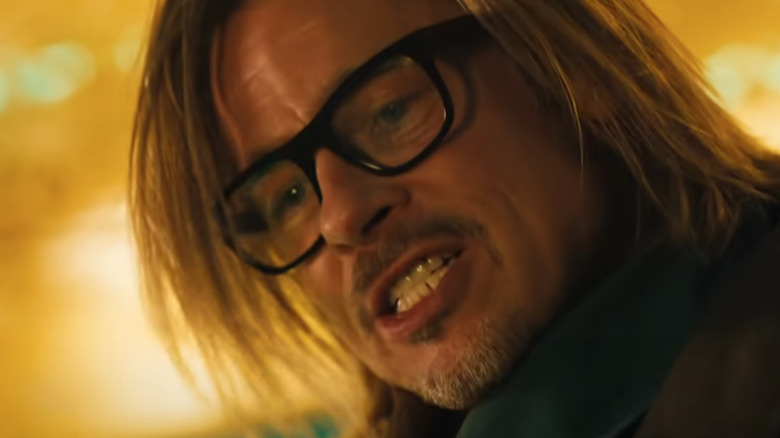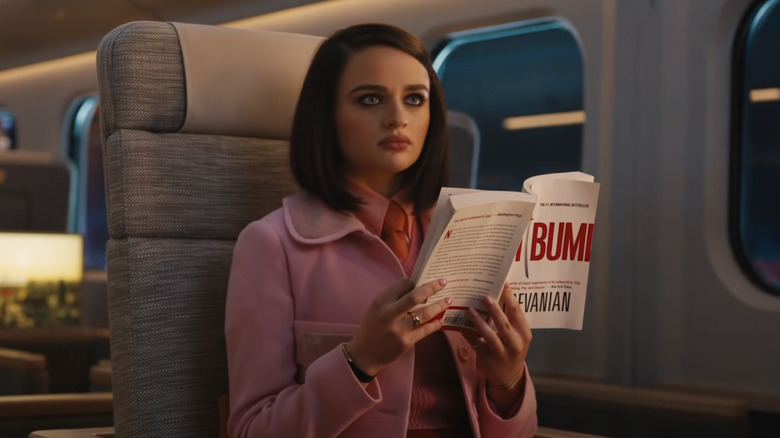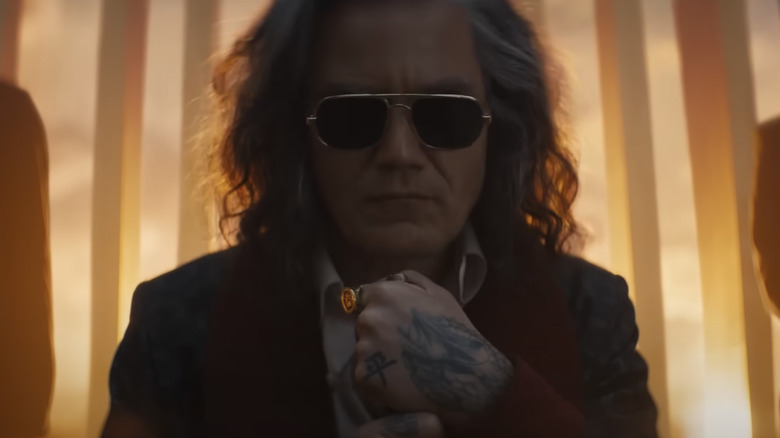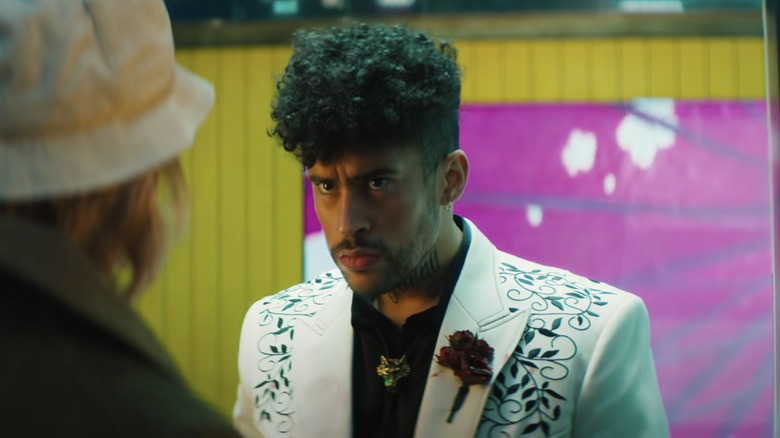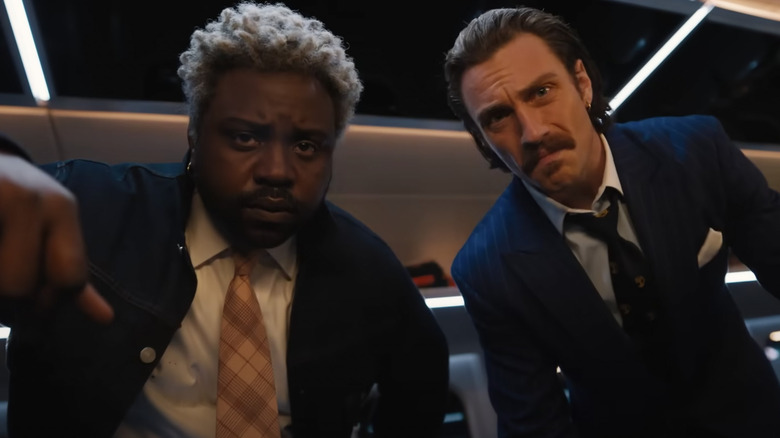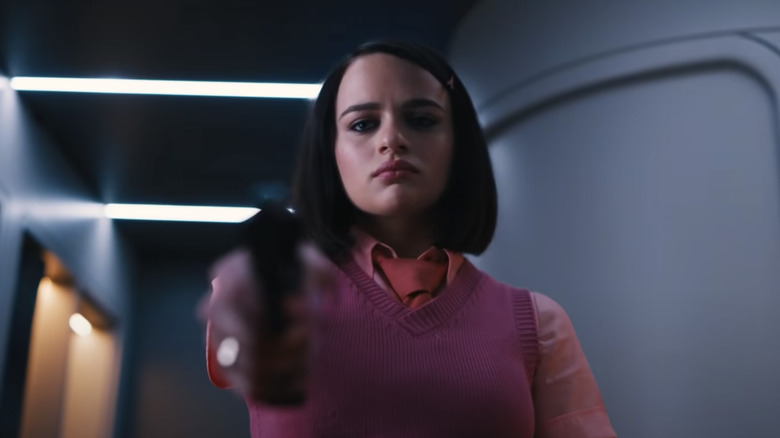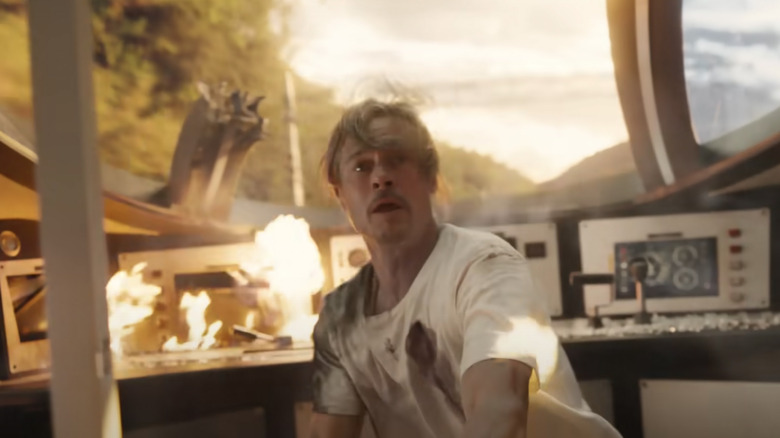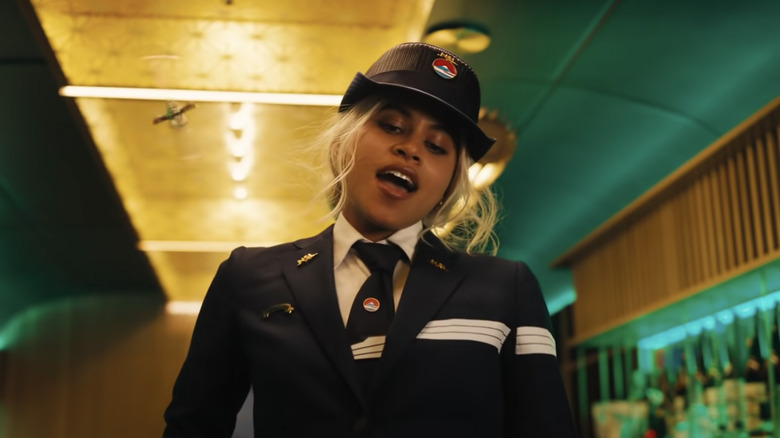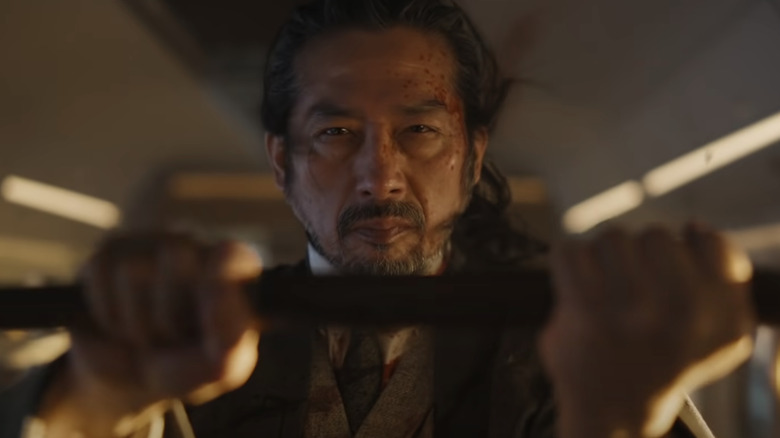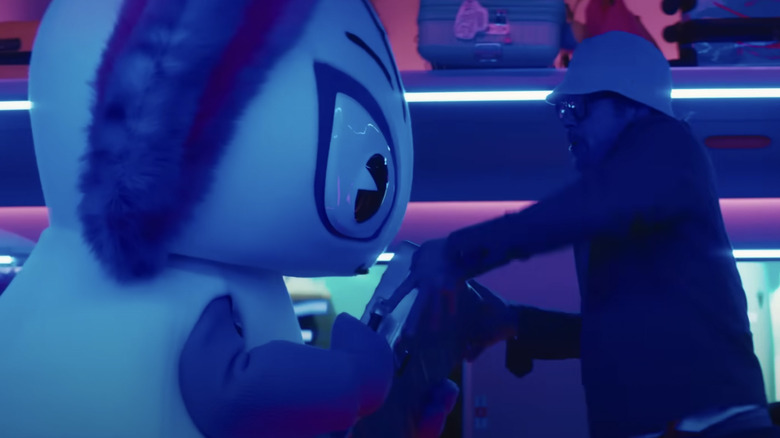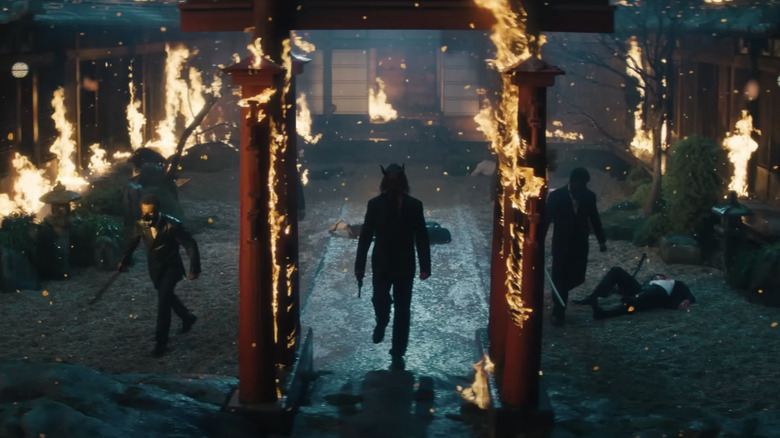How Bullet Train Differs From The Book
Translating a 400-plus-page Japanese novel with multiple characters, plotlines, and perspectives into a cohesive and entertaining 120-minute Hollywood film is no easy feat. A number of things could have gone wrong: The story could have been lost in translation due to the cultural adaptations made to appeal to a global audience; the ensemble cast could not have produced a clear protagonist for the audience to identify with; or the hurried pace of the movie might not have given viewers enough time to understand the complicated plot.
However, David Leitch's "Bullet Train" proved to be an entertaining thriller that could stand alone without its source novel, topping the box office in its opening weekend (per Deadline). "Bullet Train" is an adaptation of Kōtarō Isaka's novel "Maria Beetle,” which was a bestseller in Japan. Interestingly, the English translation of the novel was commissioned after the film rights had been optioned by Sony Pictures Releasing, translated by Sam Malissa as "Bullet Train" (via The New York Times).
Both the book and film follow a few assassins who board a bullet train, each on a different mission but interconnected in some way. There are notable deviations the movie makes from the book, most visible in the change of characters' ethnicity from Japanese to a mixture of Japanese, American, Latino, and British — which attracted criticism and accusations of "whitewashing" from the Asian American community (via AsAmNews). However, Isaka had a delighted reaction to the film, "excited" by the vibrantly violent world teased in the first trailer of "Bullet Train." Here are some of the prominent ways the film adaptation of "Bullet Train" differs from the book.
Swapped appearances and names
With all the controversial casting discussions surrounding "Bullet Train," it's no secret that there are some departures the film makes from the book. Starting with the title of the book, originally released in Japan as "Maria Beetle," a play on "ladybeetle" (an alternative name for "Ladybug," the codename of a primary character in the book) and Maria (Sandra Bullock), Ladybug's handler. With the exception of Lemon (Brian Tyree Henry) and Tangerine (Aaron Taylor-Johnson), whose names are picked verbatim from the book, the other characters are mostly referred to by different names. Brad Pitt's Ladybug is a pseudonym of the character whose real name is never revealed in the film, and the book mostly refers to him by his real name, Nanao. White Death (Michael Shannon), the main antagonist, serves the role that Minegishi had served in the book, though the film alludes to Minegishi as White Death's former boss.
Regarding appearances, the movie makes many changes to the characters' ages, nationalities, and genders. Starting with the ethnicities, while all the characters in the novel are Japanese, only two of the characters — Kimura (Andrew Koji) and his father, "The Elder" (Hiroyuki Sanada) — remain Japanese in the movie. The majority of the rest of the cast comprises American and British actors. Ladybug is portrayed in the movie as an experienced assassin who appears to be experiencing both a personal and a professional midlife crisis, while the character is really younger than most of the other characters in the book, possibly in his 20s or 30s. The Prince is a 14-year-old teenage boy in the book, portrayed by American actress Joey King as a Russian assassin posing as a British schoolgirl. It's a pretty complicated blend.
Changing villains
In the film, the big baddie is Russian crime syndicate leader White Death, who was once a trusted confidante to Yakuza boss Minegishi, only to later stab Minegishi in the back (literally) and take over his empire. Every character on the train shudders at the sound of White Death's name, eventually realizing that White Death had orchestrated their paths to collide on the train. In addition to his son (Logan Lerman), whom Lemon and Tangerine were tasked with rescuing, the climax reveals that White Death also has a daughter, who turns out to be Prince herself. The motivation behind White Death's actions is quite complicated, as he has grudges against almost every person on the train, including Lemon and Tangerine for killing his men in a previous job, his son for indirectly causing his wife's death, the Hornet (Zazie Beetz) for poisoning the only doctor who could have saved his wife, and Ladybug, who is merely standing in for the real assassin of his wife.
In the book, there is no White Death. Minegishi himself is the dreaded antagonist who had assigned Lemon and Tangerine to simply save his son, with no ulterior motives for revenge against the duo. Unlike in the film, Minegishi isn't the mastermind behind all the events transpiring on the train. Instead, he's a looming threat to Lemon and Tangerine, who have grandly failed Minegishi's mission not just by losing the briefcase stashed with ransom money, but also by letting his son die. He has no other children (certainly not Prince) and has no connection or vendettas against other characters on the train as shown in the film.
The Wolf's motivations and death
In the film, the Wolf (Benito A. Martínez Ocasio) is a Mexican assassin and former cartel member seeking revenge for the deaths of his bride and his entire cartel, who were all poisoned by the Hornet on the day of his wedding. He enters the bullet train to stumble directly upon Ladybug (who, much to his bad luck, was trying to get off the train) and immediately recognizes him as one of the waiters at his wedding. The two engage in a rather extravagantly choreographed fight, with Ladybug defending himself with the stolen suitcase while Wolf attacks with his knife. Ladybug doesn't recognize who Wolf is until after he kills him, when Maria updates him on the man's identity.
In the book, Wolf's motivation to attack Ladybug isn't as dramatic. The two characters had known each other for a while (being in the same line of work). They had an altercation one day, where Ladybug found Wolf bullying a few children, and Ladybug decided to teach him a lesson by beating him up. Wolf boarded the train not knowing that he was going to stumble upon Ladybug and would get a chance at revenge for his humiliation. While the character is described as a middle-aged Japanese man in the book, he's played by the Puerto Rican rapper Ocasio aka Bad Bunny.
The character also dies differently in the two mediums. In the film, Wolf throws the knife at Ladybug, whose metallic briefcase deflects the knife back to Wolf, stabbing him in the heart. In the book, Wolf dies as a result of a silly accident. When the train jolts, Ladybug, who has Wolf in a headlock, falls to the ground while holding Wolf's neck in his arms. In the fall, he accidentally breaks Wolf's neck.
Lemon and Tangerine aren't really twins
In the book, Lemon and Tangerine are described several times to look as though they're twins — looking very alike with the same height and lanky appearance. The assassin duo is frequently referred to as "twins" by the other characters since people can't tell which one is which amongst the two — though they repeatedly clarify that they are simply colleagues and not brothers. In the film, Lemon and Tangerine look very different from one another — in physical appearance as well as ethnicity. When people talk of the duo's exploits, they refer to them being twins, only to see in person that the two couldn't look any more different.
Their relationship also differs between the book and film. In the book, Lemon and Tangerine are simply two colleagues who have a preference for having each other as partners. They have a reliable rapport in spite of their occasional irritations with one another. Though they'd never admit it, they do share a friendly bond — shown especially when Tangerine is angered at the sight of Lemon's dead body. In the film, their relationship is shown to be much deeper, with a flashback glimpse revealing that the two were adoptive brothers since childhood — making Lemon's apparent death hit much harder for Tangerine due to their lifelong bond.
The Prince's motivations
Apart from the obvious adaptational shift of the character's ethnicity and gender, the character of the Prince also has very different motivations. In the movie, it is revealed that the reason Prince holds Kimura captive is so that he could kill the infamous crime boss White Death for her, later revealed to be her father. She harbors resentment at him for preferring her incapable brother over herself, showing no remorse at the sight of her brother's dead body by spitting on him after he was assassinated by the Hornet.
In the book, the 14-year-old teenage boy Prince is a manipulative sociopath who revels in creating mayhem among grownups, being of a mindset that he was born superior to everyone else. The book explores his philosophy on murder, his delight at being able to persuade others to do things they don't want to, and his annoyance at not being taken seriously by adults around him (like Kimura) due to his young and frail appearance. He also holds Kimura captive to kill Minegishi (White Death's counterpart in the novel), for a relatively absurd reason: that Minegishi did not take the Prince seriously. The Prince had tortured a classmate whose father was a lawyer well-connected to Minegishi. Though the father had complained to Minegishi about the Prince, Minegishi simply gave a warning to the Prince through a phone call, which offended the Prince as he felt Minegishi had "taken him lightly."
The climax and ending
The ending of "Bullet Train" is a lot more bombastic compared to the book. The train stops at its final station, Kyoto, where White Death and his army await. All the surviving characters collide at this point, and any remaining mysteries are clarified through White Death's exposition. In addition to holding Ladybug hostage and ordering his men to open the suitcase, White Death foils an assassination attempt by his daughter, the Prince, and faces off against his longtime foe, "The Elder." As soon as the men open the briefcase (booby-trapped by the Prince), it explodes, causing the train to speed out of control and crash through a village. Ladybug and the principal characters miraculously (and implausibly) survive, cheekily playing with the film's themes of fate and luck. White Death dies from using a booby-trapped gun, and Lemon runs over the Prince with a van full of tangerines.
In the book, however, Ladybug, the Prince, and Kimura's parents sit at a table engaging in a Mexican standoff of sorts. The situation is tense as Mr. Kimura aims at the Prince while Ladybug aims at Mr. Kimura (because he thinks the Prince is just an innocent 14-year-old child). Eventually, Ladybug is distracted by a snake coiling around his arms, giving Mr. Kimura the opportunity to deal with the Prince however he sees fit.
Ladybug exits the train as it reaches its destination (Morioka), where Minegishi is waiting with his army. He is picked up by Maria, and they leave the station before any conflict arises with Minegishi's men or the police. Minegishi dies at the station under mysterious circumstances, and the resolution of the story finds Ladybug at a supermarket two months later speculating with Maria about what had happened that day. Whether Ladybug was hired by Minegishi or Hornet remains a mystery, as does the fate of the Prince as Maria reveals that Mr. and Mrs. Kimura are veteran assassins who can dispose of a body so expertly that the Prince's body may never be found at all.
Hornet's deadly methods
While the Hornet's method of operation — quietly poisoning the targets with boomslang venom without anyone noticing — is the same in both the novel and the movie, the movie's depiction of the poison's effects is far more graphic. In the novel, the assassinations carried out by Hornet are so efficient that the victims' bodies bear no marks at all. Any passerby would presume that the victim was dozing off or had already passed away. This is a key factor in why Lemon and Tangerine spend a significant amount of the book scrambling to figure out how Little Minegeshi died once they discover him lying lifeless in his seat on the train. They examine his body but don't find any injuries or injection marks.
In the film, it becomes violently apparent that someone has been poisoned by the Hornet, with copious amounts of blood seeping from the victim's eyes, nose, and mouth as a result of an internal blood clot, leaving them to scream and cry for help. Any underworld professional need only take one look at the victim's corpse to identify this as the Hornet's signature work, making it all the more obvious.
Changing a key father-son dynamic
The movie gives the Elder aka Mr. Kimura an additional goal aside from rescuing his son: to kill The White Death. His vengeance against White Death is fuelled by a tragic backstory: He used to work for Yakuza leader Minegishi and was a vocal resistor to White Death's joining the clan and becoming a close confidant to Minegishi since Kimura didn't trust the man. Sure enough, White Death not only betrayed and murdered Minegishi but most of the gang members and their families too — including Mrs. Kimura. His son had survived, and the Elder is protective enough of him to come to his rescue on the train — though the two have a complicated relationship stemming from the son's alcoholism and constant disapproval from his father.
The relationship between son Yuichi Kimura and father Shigeru Kimura is thoroughly examined in the book. Shigeru is ashamed of Yuichi's alcoholism and is generally disappointed with his son, made worse by the recent hospitalisation of his grandson, Wataru, who was knocked off a rooftop by the Prince and is now in a coma. Shigeru discourages Yuichi from a career in the underworld throughout the novel, claiming he himself is a simple storeroom manager at a supermarket. Later, it's revealed that both Shigeru and his wife Akiko (alive in the book) were an efficient assassin duo 30 years back who don't seem to have lost their touch when dealing with the Prince onboard the train. They successfully rescue Yuichi and their grandson Wataru while exacting their revenge on the Prince.
Adopting a lighthearted tone
While the novel has its fair share of humor, you wouldn't necessarily think to classify it under the genre of "comedy," unlike the adaptation, which is an actual action-comedy movie. The humor in the book is primarily a dark comedy of errors, with some of the only banter being between Lemon and Tangerine, whose exchanges frequently become Tarantino-esque ramblings on topics that deviate from the actual matter at hand. When Little Minegishi is killed, their first thought is to brainstorm and discuss what kind of signal they will each leave for the other in the event of assassination so that the other person will know who the assassin is. Aside from that, the humor in the book is mostly dry and deadpan, with absurd ideas discussed among the characters in a serious tone of voice.
While the film was initially envisioned as an R-rated and grittier adaptation of the novel in the vein of "Die Hard," Aaron Taylor-Johnson said in an interview with Andrew Garfield (per Hero Magazine). "We hammed it up and made it fun. I don't know what happened, but it became a comedy!" he said. "Brian [Tyree Henry] and I felt it was our job to bring light and laughter to set, so if we made the crew laugh it was a good day." With situations and dialogue invented wholesale for the film, "Bullet Train" winds up having more humor and wit than the original novel.
Everything is connected
The backstories of most of the characters in the film are a lot more tragic, complex, and interconnected compared to the book. In the film, the Wolf is driven to board the train to avenge his bride's death at the hands of the Hornet, whereas in the book, the Wolf just happens to stumble upon Ladybug on train. He attacks Ladybug because he was humiliated and embarrassed by him in a previous encounter.
In addition to trying to protect his son from the psychotic Prince, Kimura's father boards the train because he believes White Death is responsible for everything that happened there and also wants revenge for the death of his wife at the hands of White Death, who had also betrayed and murdered his boss Minegishi and the other Yakuza members. In the book, the character has no such history with the antagonist.
If having two characters with deceased wives wasn't enough, it is revealed that White Death's reason for doing all that he does in the film was because of his wife's death at the hands of Carver (played by Ryan Reynolds in a blink-and-you'll-miss-it cameo). Resentful of his fate, White Death wanted to prove that he could himself control fate by setting up all of the assassin characters to run into (and kill) one another on the train. Ultimately, Ladybug's bad-turned-good luck averts White Death's grip on his fate, as the feared crime boss dies at his own hands by using a gun that was booby-trapped by his daughter, the Prince.
